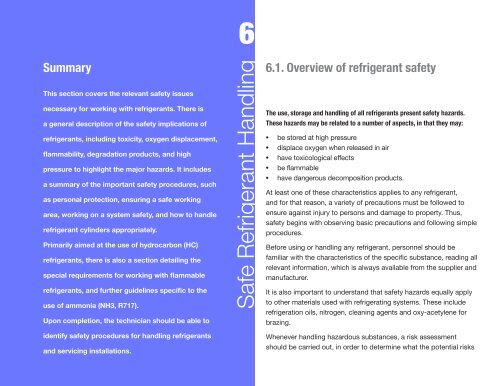Manual for Refrigeration Servicing Technicians - UNEP - Division of ...
Manual for Refrigeration Servicing Technicians - UNEP - Division of ...
Manual for Refrigeration Servicing Technicians - UNEP - Division of ...
You also want an ePaper? Increase the reach of your titles
YUMPU automatically turns print PDFs into web optimized ePapers that Google loves.
6<br />
Summary 6.1. Overview <strong>of</strong> refrigerant safety<br />
This section covers the relevant safety issues<br />
necessary <strong>for</strong> working with refrigerants. There is<br />
a general description <strong>of</strong> the safety implications <strong>of</strong><br />
refrigerants, including toxicity, oxygen displacement,<br />
flammability, degradation products, and high<br />
pressure to highlight the major hazards. It includes<br />
a summary <strong>of</strong> the important safety procedures, such<br />
as personal protection, ensuring a safe working<br />
area, working on a system safety, and how to handle<br />
refrigerant cylinders appropriately.<br />
Primarily aimed at the use <strong>of</strong> hydrocarbon (HC)<br />
refrigerants, there is also a section detailing the<br />
special requirements <strong>for</strong> working with flammable<br />
refrigerants, and further guidelines specific to the<br />
use <strong>of</strong> ammonia (NH3, R717).<br />
Upon completion, the technician should be able to<br />
identify safety procedures <strong>for</strong> handling refrigerants<br />
and servicing installations.<br />
Safe Refrigerant Handling<br />
The use, storage and handling <strong>of</strong> all refrigerants present safety hazards.<br />
These hazards may be related to a number <strong>of</strong> aspects, in that they may:<br />
• be stored at high pressure<br />
• displace oxygen when released in air<br />
• have toxicological effects<br />
• be flammable<br />
• have dangerous decomposition products.<br />
At least one <strong>of</strong> these characteristics applies to any refrigerant,<br />
and <strong>for</strong> that reason, a variety <strong>of</strong> precautions must be followed to<br />
ensure against injury to persons and damage to property. Thus,<br />
safety begins with observing basic precautions and following simple<br />
procedures.<br />
Be<strong>for</strong>e using or handling any refrigerant, personnel should be<br />
familiar with the characteristics <strong>of</strong> the specific substance, reading all<br />
relevant in<strong>for</strong>mation, which is always available from the supplier and<br />
manufacturer.<br />
It is also important to understand that safety hazards equally apply<br />
to other materials used with refrigerating systems. These include<br />
refrigeration oils, nitrogen, cleaning agents and oxy-acetylene <strong>for</strong><br />
brazing.<br />
Whenever handling hazardous substances, a risk assessment<br />
should be carried out, in order to determine what the potential risks

















